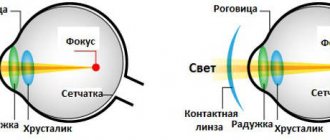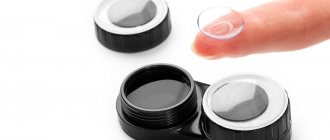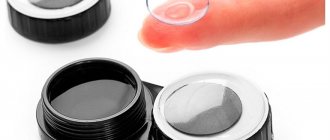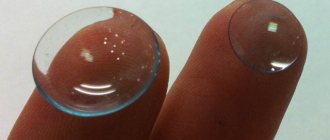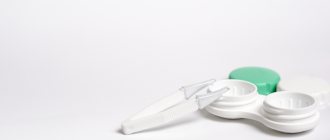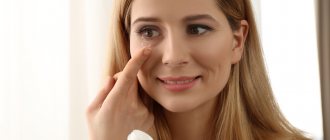Colored contact lenses allow you to change your natural eye color to create bold, daring or elegant looks. They can not only diversify your everyday look, but also create an appropriate image, say, not for Halloween. Colored lenses can cope with any task, the main thing is to choose them correctly so as not to harm the organs of vision.
Share
Tweet
Share
Cool
Send
How to eliminate hyperopia
Optics
Vision correction is carried out taking into account the degree of positive vision and concomitant pathologies. If vision is plus 1 dpt, then in most cases corrective optics are not prescribed. When this value approaches 1.5 Dpt, the ophthalmologist may suggest glasses or contact lenses for correction. Lenses must be collective. For older patients, if myopia or astigmatism has previously been diagnosed, two pairs of glasses will be needed - one for distance and one for reading. To avoid confusion, today's glasses can be custom-made with multiple optical zones. They are called bifocal or multifocal, as they include optical areas with different degrees of refraction.
“Plus” vision is corrected with collective lenses
Young people may be prescribed contact lenses for greater comfort. This optical system is installed directly on the eye and has a number of advantages for the user. Firstly, there is no image distortion or glare like with glasses; secondly, the power of a contact lens may be less than a spectacle lens due to the lack of distance to the cornea; thirdly, a more aesthetic appearance, no fogging, ease of use when playing sports or in the pool.
The lenses are convenient because they can be selected according to your wearing schedule: you can wear the optics all day (12 hours) and take them off at night, or you can choose weekly or even monthly lenses that do not require removal from the eyes during this period.
Contact lenses can also have multiple areas of varying optical power, allowing them to be used for both reading and distance vision at the same time.
Bifocals with reading area (A) and distance (B)
Previously, the material of contact lenses did not allow them to be made powerful enough for high degrees of farsightedness, and if the “plus” was large, then it was necessary to use glasses. New materials make it possible to produce contact lenses with an optical power of +6 Dpt. It should be remembered that lenses should not compensate for vision 100%. This approach makes it possible to maintain the tone of the ciliary muscles of the eye and maintain their participation in the accommodation process.
As an option for correcting positive vision, you can choose implantable contact lenses. They will need to be installed directly into the eye in front of the iris or in front of the lens. The lens is very elastic, which allows it to be inserted through a very small incision into the anterior or posterior chamber of the eye, where it unfolds independently.
This correction method is used for high levels of “plus” vision, for which laser correction is contraindicated, or the patient has a very thin cornea or defects in the form of keratoconus. Implantable lenses provide the same effect as vision correction with regular glasses or soft contact lenses, but are more convenient in everyday life.
With the help of various optics, you can achieve instant vision improvement.
Laser correction of farsightedness
This method of improving vision is suitable for patients aged 18 to 45 years and with visual acuity up to plus 5. The impact in this case is applied not to the lens, but to the cornea - another refractive structure of the eye. The laser “burns” a certain thickness of the cornea in designated areas. This will give her new geometry and allow her to change focus.
The procedure itself lasts about a quarter of an hour and recovery after it is also short. After just two hours, the patient can see the world differently. To further maintain the effect of the operation, the doctor usually prescribes anti-inflammatory (Diftal, Diclofenac) and moisturizing eye drops (Dexpanthenol, Korneregel), complex vitamin preparations with lutein and microelements for oral administration (for example, Taxofit).
Scheme of laser correction of the cornea profile for farsightedness
Lens replacement
With very high levels of positive vision (up to +20 Dpt), especially in older people, it would be most rational to resort to surgery to replace the lens with an artificial lens - lensectomy. The natural lens is destroyed and extracted, and a lens is placed in its place in the capsule. It can have a special shape that allows you to focus images from different distances. Simpler options have one focus, so the patient will need reading glasses, but vision is restored to 100%.
The decision on the advisability of such radical intervention must be made by the doctor. The patient should know that lens replacement is carried out quite quickly and under local anesthesia, and does not require a long stay in the clinic. In terms of its effectiveness, it ranks first among methods of treating farsightedness in older people.
Are colored contact lenses harmful to the eyes?
Nowadays, colored lenses have become a common accessory, such as a handbag or earrings. And naturally the question arises about the safety of wearing them.
Hypothetically, any contact lens can harm the eyes, but the harm occurs only through the fault of the user.
How can they be harmful?
Main causes of harmful effects:
- Violation of operating rules.
- Purchase without examination by an ophthalmologist - the size and diameter of the curvature are not selected.
- Purchasing cheap products, the manufacturing of which did not comply with safety norms and standards.
Important! All other myths about the dangers of contact lenses are untrue.
The most common myths about the dangers of colored contact lenses:
- Negatively affects the cornea of the eye. Pigmented contact lenses are made from the same materials used for vision correction. Hydrogel or silicone hydrogel materials are mainly used in the production process. The advantages and safety of silicone and hydrogel have been known for a long time; wearing lenses made from these materials is safe and comfortable.
- Cause allergies. This situation can only happen if the lens is defective. Currently, high-quality products are created using the latest technologies, and the coloring pigment is included in the structure of the material.
- Impairs vision . This is not true; decorative contact lenses do not affect visual acuity in any way.
- Change color perception. When wearing colored contact lenses, image quality does not decrease, since the pupillary area is not stained with pigment and remains transparent. In a dark room, the pupil is known to dilate and may be slightly blocked by the colored area of the lens, resulting in partial blurring of vision. This does not cause severe discomfort, but still experts do not recommend wearing contact lenses at night when you plan to drive a car.
- They are difficult to care for. Caring for colored lenses is no different from caring for regular ones. Experienced users spend no more than a couple of minutes a day on this.
Thus, if a person chooses contact lenses correctly (after examination by an ophthalmologist), follows the rules of wearing them, and takes care of them every day, there will be no harm to eye health.
Selection of vision correction products
Anyone who would like to know information about lenses with diopters, what this product is and how to use it correctly, must remember to follow certain rules. Firstly, to select a suitable model, you need to contact an ophthalmologist.
First of all, when selecting the right model, the doctor needs to decide how many diopters of vision the patient has. These can be numbers from 0.25 to several units (in the most serious cases up to 30) with a positive or negative value. To do this you need to use special devices. The doctor must also know information about what pathologies of the eye system a person has. Therefore, if the patient has diseases of the organs of vision, he needs to be told about this before selecting lenses.
At the initial stages of wearing, all models provoke some discomfort: dryness, a feeling of “sand” in the eyes. This is normal. However, if the patient feels discomfort for a long time, he should tell the doctor about it.
Features of wearing and care
There are the following rules for using colored contact lenses:
- New contact lenses should be placed in a special solution for at least 2 hours before first use. It is forbidden to use it repeatedly; you must pour fresh one each time.
- Before putting on or removing lenses, wash your hands with soap and water.
- Products must not be washed with water or other liquids that are not intended for this purpose.
- You cannot wear it longer than the service life stated by the manufacturer, since after its expiration the material becomes unusable.
- Experts do not recommend wearing colored lenses more than 8 hours a day. The fact is that the colored layer allows less oxygen to pass through to the cornea. You should not sleep in colored lenses, and in addition, it is recommended to give your eyes a rest - do not wear them at least once a week.
- It is not advisable to wear during colds and viral diseases, when there is increased tearing.
- Put on before applying decorative cosmetics, and remove before you begin to remove makeup.
- When using hygiene products in the shower, you need to keep your eyelids tightly closed so that the product does not get into your eyes.
- You should not let other people wear lenses or try them on - this is a gross violation of hygiene rules.
- Do not use a solution whose expiration date has already expired.
- Do not reuse the same solution.
- The container in which the lenses are stored must be changed every month to prevent contamination. Bacteria from the lenses enter the solution, and from it onto the walls of the container. Thus, it becomes a source of bacteria, even if the solution is changed regularly.
- It is not advisable to swim in artificial or natural bodies of water while wearing lenses, even if special glasses are used.
- If irritation or discomfort occurs in the eyes, you should immediately visit an ophthalmologist.
- Before putting on, you need to carefully inspect the lenses for damage; they can only be used if the integrity is not compromised,
- To learn how to properly put on and remove lenses, you need to consult an ophthalmologist.
- When selecting mascara and eye shadow, you need to give preference to those products that are recommended by ophthalmologists - they will not crumble and get into your eyes.
Important! Peroxide cleaners may cause color pigment to fade and should not be used to clean contact lenses.
Diopter difference between eyes. Anisometropia
However, as the pathology progresses, binocular vision is lost, which leads to difficulties in orienting in space and responding to external stimuli. Let's take a closer look at what anisometropia is, what causes it, what symptoms it manifests, and how the disease is treated.
Anisometropia is an ophthalmological pathology in which the refractive power (refraction) is impaired in two eyes. This is a dangerous disease that has serious complications: strabismus or loss of vision due to inactivity of the eyes.
Often this disease develops together with astigmatism (a vision defect in which the patient sees objects unclearly due to the irregular shape of the cornea or lens).
Human eyes must have the same degree of diffraction. The lens, cornea, sclera and other elements of the eye must refract light rays equally in both the left and right eyes. In this case, the picture is clearly transmitted to the brain.
The norm is considered to be a deviation in diffraction between the two eyes of up to two diopters. The patient does not observe any discomfort, both eyes see normally, the concepts of a sick and a healthy eye are not distinguished.
When the difference in diffraction is greater than 2 diopters, a state of anisometry begins, characterized by:
- Deterioration in the quality of binocular vision. By closing your eyes one at a time, you will notice that one of them sees much better. Parents whose children suffer from anisometry notice that the child squints while reading books or studying distant objects.
- The appearance of accompanying symptoms – diplopia, myopia (false), fog in the eyes.
- Fatigue quickly when working with text or small objects. The body undergoes a process of restructuring the visual process, in which the healthy eye takes on the basic load. This causes fatigue, which is accompanied by headaches.
Basic information
It has been proven that anisometropia is caused by both different refractive powers of the optical apparatus of one and the other eye, and different lengths of the anatomical axis in both eyes. Most often it is congenital.
There are no specific figures in the ophthalmological literature regarding the frequency of anisometropia in humans. However, many authors note that mild degrees of anisometropia are more common than is commonly believed.
Anisometropia significantly affects the binocular vision apparatus. True, with a small degree of anisometropia. Despite the unequal clarity and size of the images of the object on the retinas of both eyes, binocular vision is preserved.
Anisometropia of 2.00 or more causes disruption of binocular vision (especially in children) due to difficulty merging images that are unclear in one or both eyes. In this case, the image on the retina of the worse-seeing eye begins to be suppressed, monocular vision and concomitant strabismus appear.
Anisometropes, in whom one eye has emmetropic refraction, usually use this better eye for vision. If the degree of refractive error of the second eye is small, then anisometropia is diagnosed only when checking visual acuity in an ophthalmology office.
If an anisometrope has hypermetropia in one eye and myopia in the other, binocular vision is impaired. A hypermetropic eye is used for distance vision, and a myopic eye is used for near vision.
Anisometropia can occur in different ways:
- in one eye there is normal refractive power, and in the other it is pathological;
- two eyes have the same refractive power, but different degrees of reduction in visual acuity;
- both eyes have different pathological refractive powers.
If the difference in the refractive power of the eyes is 2 diopters, then a person may simply not notice the symptoms. But if the difference is more than 2 diopters, then loss of binocular vision is possible. As a result of such complications, the image of the object is captured in turn by the right and then the left eye.
There are 3 stages of the disease:
- stage I – about 3 diopters;
- stage II – from 3 to 6 diopters;
- stage III – from 6 diopters or more.
Types of ophthalmological pathology by type of disease:
- axial - the refractive power is the same, but the length of the axis in each eye is different;
- refractive – the axes are the same, but the refractive power is different;
- combined – a combination of two types of disorders.
Glasses for Myopia – What You Need to Know
Decreased visual acuity is not only a pressing medical, but also a social problem. Today, a huge number of young and middle-aged people suffer from myopia - a vision defect in which a person has poor distance vision and cannot clearly distinguish objects at a distance.
With myopia, refraction, the refractive power of the eye, is impaired. To clearly see an object at a far distance, a person has to squint. Therefore, in ophthalmology there is another term for this visual defect - myopia (in Greek “myops” - “squinting”).
The most common way to eliminate this pathology of eye refraction is to wear glasses for myopia.
Why does myopia occur?
In normal vision, rays of light emanating from distant objects pass through the eye's optical system and converge on the light-receiving membrane of the retina. With myopia, the rays are projected in front of the retina, scattered and hit the retina in an unfocused form.
As a result, the image turns out blurry, blurry, unclear. This visual defect develops due to the excessively strong refractive power of the cornea and lens, or due to an increase in the length of the eyeball, which takes on an ellipsoidal shape.
To correct the refractive error of the optical system of the eye due to myopia, ophthalmologists select appropriate glasses for the person.
Features of choosing glasses for myopia
The refractive power of glasses is expressed in diopters. If myopia develops, minus (negative) diopters are selected. With an initial degree of myopia (up to -3.0 diopters), glasses can completely restore visual acuity. However, quite often eye doctors recommend wearing them only as needed. Many ophthalmologists believe that constantly wearing glasses weakens the eye muscles, so myopia will progress quickly.
If the degree of myopia is expressed in the range of 3.0 - 6.0 minus diopters, it is no longer possible to do without glasses. In the middle phase of refractive error, ophthalmologists try to accurately select the diopters of glasses. Wearing them constantly allows you to completely correct your vision and save a person from many problems that arise in everyday life.
For high myopia (above -6.0 diopters), doctors recommend wearing glasses one diopter less than the diagnosed visual impairment. Among ophthalmologists, this approach to selecting glasses is called vision correction based on tolerance.
In this case, 100% vision correction is not achieved, but the person gets rid of increased eye fatigue.
In addition, when selecting corrective glasses for any degree of myopia, the distance between the centers of the pupils of the eyes should be taken into account. When wearing glasses with an incorrectly selected center distance, your eyes can quickly become tired and dizziness may often occur.
Appearance of glasses
It is well known that when looking at a person, glasses are the first thing that catches your eye. Therefore, from an aesthetic point of view, you should approach the choice of frames and lenses for glasses responsibly. In particular, for a person with a round face, it is best to choose square glasses, and for people with elongated facial features and a long nose, the most preferable choice is round glasses.
Much depends on the material from which the glasses are made. The plastic frame is not dangerous to drop, but if you step on it or accidentally sit on it, it breaks in half. The metal frame is flexible and bends easily.
On the one hand, this is good (the frame takes the shape of the face), on the other hand, it is bad: it is not always possible to correctly straighten a damaged frame and give it its original shape.
With the current level of industrial production, purchasing good glasses for myopia is not difficult. The main thing: the correct selection of diopters and comfort when wearing glasses!
Main characteristics
To select contact lenses with diopters that are comfortable to wear, it is best to contact specialized optical stores or clinics, where ophthalmologists will quickly select the necessary product. It wouldn't hurt to know.
Optical power (diopter)
In the center of the optics there is an optical zone through which a person looks. Depending on the need, the ophthalmologist selects lenses with certain diopter values.
As a rule, lenses combine several optical power parameters, which makes it possible to see objects both near and at a distance.
Diameter
Measured to one decimal place in millimeters. For both eyes this value will be the same. The correctness of the diameter measurements determines whether a person will be comfortable wearing optical pads.
Radius of curvature
Indicates the degree of curvature of the inner side of the cornea. It is individual for each person and depends on the anatomical structure of the eyeball. Properly selected optics should fit tightly to the cornea and exactly follow its shape.
Center thickness
The degree of wearing comfort, as well as the ability of the optical pad to transmit oxygen, depends on it. This parameter depends on the material of manufacture, the optical zone, the degree of moisture permeability, and the presence of coloring pigments.
The thickness of the soft optical overlays in the center is from 0.035 mm to 0.20 mm, and at the edges - 0.01-0.05 mm. Solid - 0.10-0.12 mm in the center and 0.08-0.12 mm at the edges.
Moisture content
Moisturizing the membrane of the eye is necessary to maintain healthy vision. Contact lenses with and without diopters are made from hydrogel materials with an optimal level of humidity. The most comfortable moisture content will be below 70%.
Oxygen permeability
Standard prescription contact lenses made from hydrogel polymers are not capable of transmitting oxygen. Air penetration occurs due to the presence of water in the product. Accordingly, the moisture content in such lenses should be at a high level (but not exceed the permissible values).
In the new generation of optics made of silicone hydrogel polymers, the ability to transmit oxygen does not depend on the water content in them, so they can be worn without interruption for up to 10 days.
Multi-focus optics
So, where should you start selecting the necessary optics? As with glasses, you need to know the diopters of contact lenses that correct visual impairment. To do this, they undergo an examination in the ophthalmologist's office. Visual acuity is determined according to the Sivtsev table and using computer refractometry. The prescription for glasses that the ophthalmologist writes out contains information about the type of refractive error: myopia, farsightedness, astigmatism and an indication of the power of the optics that is necessary for correction. By studying the recipe, you can determine for yourself what kind of optics you need.
If the prescription contains a “ ” sign, this means that your optics should reduce the refractive power of the lens in case of farsightedness. When selecting a correction method, they are guided by the optical power of the eye. With an average degree of hypermetropia up to 2 diopters. Optical correction products are not yet prescribed.
When a doctor puts a “-” sign in a glasses prescription, this means that the optics should bring distant objects closer and improve vision in case of myopia. There is a ranking of myopia according to the following indicators: mild –3 diopters, moderate –3–6 diopters, severe – more than 6 diopters. You need to choose optics in such a way that vision compensation is not 100%, just like when correcting hyperopia.
More recently, difficulties in selecting contact optics arose when people with high rates of myopia needed them. But modern technology allows us to produce lenses with big disadvantages. The limit value for today is 20 diopters for Proclear products. Most manufacturers offer hydrogel lenses in the optical power range from 6 to –10 or –12 diopters. (Acuvue, AirOptix, Pure Vision, Wohlk).
In such bifocal lenses, the difference in dioptres in the central and upper zones allows the eye to see well both close-up and distant. These zones are sharply demarcated in bifocal lenses (into the upper and lower segments or in the form of concentric circles) and smoothly flow into one another in multifocal lenses.
Such optics can only be selected by a qualified ophthalmologist.
| Number of diopters | Degree of violation | Features of choosing a frame | Wearing Features |
| From 0.1 to 3 D | Weak | Any frame will be suitable for lenses with this value. The main thing is that the person likes it outwardly and suits it. | Such glasses are prescribed, as a rule, only for working with objects located nearby. This accessory should also be used when working at a computer or for reading. |
| From 3 to 6 D | Average | The glass is stronger, so it will be thick. This can be hidden with colored or black and white frames. | These lenses are designed to permanently improve visual acuity. They need to be worn all day long, as otherwise the quality of life deteriorates significantly. This brings a lot of inconvenience to a person. |
| From 6 D and more | High | Such lenses are very massive and thick, as they are designed to correct advanced forms of hypermetropia. The frame should be light in color with wide arms that will hide the thick glass. | This degree of impairment is a serious obstacle to normal life. At the same time, a person sees poorly not only near, but also distant objects. The lenses are massive and heavy. These glasses need to be worn constantly, since without them you can hardly see anything. |
We figured out what diopters mean in farsightedness. From all of the above, the following conclusions can be drawn:
Hypermetropic disorder is classified using plus diopters. The higher the number of diopters, the worse the patient’s quality of vision. The greater the degree of impairment, the thicker and more massive the lenses in the glasses. The choice of frames must be approached especially carefully, since this determines how beautiful and neat the medical accessory looks on a person. It is extremely important to adhere to your glasses wearing routine. If the damage is minor, they can only be worn when working at close distances.
Patients with moderate and high degrees of pathology need to wear them constantly.
Acuvue 2 Colors Enhancers
The model is presented in three shades - green, turquoise, blue. The lenses are made of a soft, flexible and ultra-thin polymer. They have average oxygen permeability (33%) and optimal moisture content (58%). The built-in UV filter protects the cornea of the eye from the harmful effects of sunlight.
Acuvue 2 Colors Enhancers have undergone a series of tests, the results of which have confirmed their safety for use by people prone to allergic reactions. Ophthalmologists recommend removing optics at night to provide rest to the eyes.
Each package contains 1 or 3 pairs of lenses. They should be changed every week if worn constantly. An additional option that increases the degree of wearing comfort is the presence of a double radius of curvature and a small thickness of the optical zone.
OKVision Fusion Nuance
Ultra-thin lenses with diopters, made using the latest technology, which allows the color pigment to be evenly distributed inside the product. The thickness of the lining does not exceed 0.06 mm.
The optics have a high moisture permeability of 45%, oxygen permeability at 35%. Optical power up to -7 dioptres.
They also produce models that are not intended for vision correction. They are used as an image accessory. Not suitable for 24/7 wear. They are replaced every 14 days.
Ultra Flex
The lenses are available in blue, green and aquamarine shades. They are somewhat inferior to the models described above in a number of indicators. Ultra Flex are made of thin, elastic polymer. Their feature is their long service life.
Moisture content level is 38-40%, breathability is 29%. Optical power ranges from 0 to -6 diopters. Radius of curvature 8.6 mm. There is no dark rim on the lenses. They should be changed after 6 months of continuous wear.
Freshlook Color Blends
Freshlook Color Blends are an option for those who want to completely change their eye color. In the line you can find models of brown, gray, blue and rarer colors.
Thin hydrogel lenses (maximum thickness 0.05 mm), quite soft, have a sun filter.
Moisture content – 55%, air permeability – 40%. Optical power – from 6 to -8 diopters. The radius of curvature is 8.6. Diopter lenses are sold in packages of one pair. They are changed after a month of continuous wearing.
Freshlook Dimensions
The lenses have a low color pigment density. They are presented only in natural shades, so they do not hide the natural color of the iris. Optical overlays of this type will be optimal for those with dark eyes.
The optics are made from the modern polymer femfilcon. They are characterized by approximately the same degree of moisture content and breathability - at the level of 55%, and optical power ranging from 0 to -8 diopters.
Ophthalmix Butterfly Three-tone
The color range is extensive. You can choose a model ranging from a light bluish tint to an exotic lavender.
The structure of the product is ultra-thin. The inner surface is smooth, which increases wearing comfort. Moisture content is high (42%), oxygen permeability is 25%. Optical power ranges from 0 to -10 diopters. Designed for daytime wear. Service life – 3 months.
How much less vision should the lenses have? Correction with glasses
Our readers successfully use Oko-plus to treat joints. Seeing how popular this product is, we decided to bring it to your attention. Read more here...
Myopia, or myopia, is inherited, so children from such families need consultation with an ophthalmologist and subsequent vision correction first. With myopia, a child has poor distance vision. At the same time, the eyeball lengthens (normally it is perfectly round), and the image is focused in front of the retina, and not exactly on it. The picture turns out blurry, clearly visible only at a very close distance. Read more about myopia in children →
The easiest way to correct it is with glasses. Previously, doctors selected eyepieces with incomplete correction; in those days it was believed that this could slow down the development of myopia. Researchers from many countries have studied the issue and come to the conclusion that this is wrong. Complete correction does not accelerate the progression of myopia in the same way as incomplete correction.
Modern glasses for children come in two types: multifocal and perifocal. Multifocal is a combination of distance and near correction in one lens. With myopia, the eye muscles constantly strain to focus when looking into the distance. When you need to look close, they can no longer completely relax, which is why the eyeball gradually changes its regular round shape to a pathological oval. Multifocal glasses take this into account; when wearing them, the eye muscles can relax completely. This delays the progression of myopia.
Rules for storing and caring for glasses
In order for your glasses to serve you for a long time, you need to carefully care for them and store them correctly:
- Protect from sun, scratches, dust and dirt. Keep your glasses in a case, even if they are not in your bag. It is designed to prevent the lenses from being damaged or scratched ahead of time. At home, try to keep your glasses away from direct sunlight, as they will also damage the eyepieces. Well, of course, don’t put your glasses down.
- Wipe the lenses with a clean suede cloth or special alcohol wipes for glasses. If you wipe them with anything, for example, the edge of a sweater or a towel, then over time scratches will form due to dirt that gets onto the lenses from the fabric. Scratched glasses only harm your eyesight.
- Plastic, progressive and photochromic lenses require special careful and thorough care - optics usually tell you how to clean them. The case also needs to be periodically cleaned of dirt and dust.
- Do not loosen the temples. Get into the habit of taking your glasses off and putting them on using both arms to avoid loosening the temples.
- You should not use glasses as a hairband: this can cause the temples to become loose and your hair to scratch the lenses. The lenses on your glasses may shift and be positioned asymmetrically.
- Do not wear glasses in the bathhouse or sauna. Wear special water-retaining correction equipment in the pool.
- Eyeglass lenses can become damaged if they are left in hot areas for long periods of time, especially in the kitchen and bathroom. There is a very high risk of dirt, grease, chemical liquids or hot steam getting on them.
- It is recommended to choose a hard case with a lid.
- Using heating devices near glasses can melt the material of the frames and lenses, especially if they are made of plastic.
Features of glass lens care
The big advantages of using glass lenses are their durability and resistance to physical irritants. The disadvantages are their severity and thickness: the higher the diopter, the greater the massiveness. Caring for glass eyepieces is easy: just wash them with a special liquid or warm water and soap. For wiping, use a soft cotton cloth or a special microfiber cloth.
Features of caring for plastic lenses
The advantages of plastic lenses are their modernity, convenience, light weight and thin thickness. Disadvantages - softness and instability to damage: the appearance of scratches, microcracks, all kinds of stains that interfere with vision. Caring for eyepieces with plastic lenses requires increased care.
A very soft cotton cloth is used for wiping. Wash plastic lenses with warm water and mild soap. There are also special wipes for wiping glasses.
If your vision correction product has an anti-reflective or sun protection coating, do not wash it with caustic chemicals.
How to use it correctly
Before deciding to use contact lenses with diopters, you should familiarize yourself with the basic rules for wearing them:
- Only an ophthalmologist can choose the right model after conducting a series of studies.
- Products should be purchased in specialized stores.
- Read the instructions carefully before use.
- Have an annual examination with a doctor to monitor visual acuity.
- Installation of lenses with diopters on the eyeball is carried out with clean hands.
- If the optics are damaged or deformed, they must be replaced immediately.
- If a foreign body gets on the lens, it should be removed to avoid damage to the cornea.
- You should always put on your optics before applying makeup.
- In order to avoid drying out of the mucous membrane, it is necessary to periodically use moisturizing eye drops that are suitable for the diopter lenses used.
- It is better to put on and take off products starting from one eye. This will help not to confuse them if the parameters of the overlays differ.
- Place the lenses using your fingertips to avoid damaging the cornea with your fingernails.
- Before installing the optic, inspect it for damage, moisture levels, and proper positioning.
- After removing the lenses, pour out the solution and store the container empty in a dry place.
- Do not wear optical pads for longer than prescribed. Reuse disposable products.
- Avoid wearing optics during respiratory illnesses.
- It is strictly forbidden to store lenses with and without diopters in an unsuitable solution and use it several times without changing it.
Glasses and lenses
To correct existing visual impairment, doctors prescribe contact or spectacle correction products with the required diopter lenses (“+” or “-”).
Lenses with a “+” sign
This type of lens is prescribed when it is necessary to reduce the refractive power of a transparent body. As a rule, if the observed image of closely located objects is focused not on the inner shell of the visual organ, but behind it. The stage of development of hypermetropia in a person is determined by his direct study of the tables, which were written about just above, through the lenses offered one by one by the doctor.
In modern ophthalmology, there are mild (up to +2 diopters), moderate (up to +5 diopters) and severe (above +5 diopters) degrees of hypermetropia. The stage of the disorder determines the subsequent treatment prescribed. For example, in case of mild visual impairment, no correction is carried out. If it is moderate, glasses or contacts are prescribed, but if it is severe, only glasses are prescribed.
For hypermetropia, lenses are usually selected in such a way that vision is not corrected 100%. This is done in order to maintain the functionality of the main muscles of the organ and prevent them from atrophying in the future. The use of products with a “+” sign is limited to the study of objects located in close proximity. For example, they are used when studying books or when sitting for a long time watching TV.
Lenses with a "-" sign
Corrective products bring a distant object closer, thereby stabilizing the organ’s ability to have good visual perception at different distances. Such products are prescribed when it is necessary to correct the visual perception of a myopic person. Focusing of the observed object clearly on the fundus is carried out by dispersing the light beam due to its additional refraction.
Ophthalmologists distinguish three stages of the disorder, corrected by wearing optics with a “-” sign: mild (up to -3 diopters), moderate (up to -6 diopters) and severe (more than -6 units). It often happens that with a severe degree of hypermetropic disease, a person simultaneously begins to develop myopia.
When the diopters of both organs of vision coincide, it is not difficult to correct the existing violation. It is more difficult to do this if there is a difference in vision. In cases where the optical power of both eyes is almost the same, doctors prescribe products with the same diopters in glasses, focusing on the smaller value. If the power has a difference of more than 3 diopters between the two eyes, then contact correction products are prescribed.
Prescription glasses: benefits
One of the most popular ways to correct vision is wearing glasses. For decades, people who suffer from diseases of the visual system have successfully used innovative developments in the field of optics. Such inventions include glasses for correcting vision and sunglasses with diopters. Their main advantage is the ability to adjust the power of the lenses in accordance with the individual characteristics of each person.
Professionals call these glasses adaptive. That is, those that adapt to any vision. There are cases when the indicators in both eyes are different. In such cases, it is necessary to order glasses with different diopters. A device for improving vision can have an attractive appearance: bright color, beautiful frame. Also, some models are complemented by a chain, which will make use more convenient.
It is important to consider that ready-made glasses with diopters are designed for the same visual strength in both eyes
The difference in diopters between glasses and lenses. Vertex correction – vertex distance
Vertex correction, vertex distance - everyone who wears contact lenses or glasses has probably heard such expressions. What is vertex distance and vertex correction? Why do you need to know and take into account the vertex distance and how to correctly calculate the vertex correction? Is there a difference between the diopters of glasses and lenses, and what should be the difference in diopters between contact lenses and glasses? In this article we will try to answer these questions.
Vertex distance is the distance from the back surface of the spectacle lens to the top of the cornea of the eye. Normally, the vertex distance should be 12-15 mm. You can measure the vertex distance using a special or regular ruler. It is this vertex distance that guarantees that the image passing through the surface of the spectacle lens will fall on the retina and, accordingly, the person will see the objects in question well and clearly in the glasses.
What happens if the vertex distance shifts?
If the vertex distance does not correspond to the norm, the corrective power of the spectacle lenses changes.
Dispersive minus lenses
Spectacle lenses with minus diopters are divergent; they are designed to compensate for the strong refractive refraction in myopic people, in whom, without correction, the image is located in front of the retina. Correctly selected minus lenses, taking into account the vertex distance of 12-15 mm, move the image onto the retina and ensure clarity of vision. Increasing the vertex distance with minus lenses (moving away from the eyes) leads to the fact that the image will again move and be in front of the retina, which means the clarity of vision will deteriorate.
If the vertex distance is reduced (closer to the eyes) with minus lenses, then you can get an excessively strong correction.
Converging plus lenses
Plus lenses are converging and are used to correct weak refraction in hyperopia and presbyopia.
With hypermetropia, the image falls behind the retina, and correction with converging plus lenses moves it onto the retina and makes the image clear.
When the vertex distance from the eyes shifts, that is, when it increases, the refractive power of the plus lens will increase, that is, excessive correction, since the image will move in front of the retina. When the plus lens approaches the eyes, the image will move behind the retina and visual acuity will decrease again.
Thus, changing the vertex distance when correcting with plus and minus lenses will lead to opposite results. Therefore, even if adequate spectacle correction is selected, but the vertex distance is not observed, visual acuity in glasses may differ from the selected correction.
This is why it is important to consider the vertex distance when selecting glasses and ensure the correct fit of the frames even before the glasses are made
Vertex distance and contact lenses
Vertex distance is an indicator characteristic only for spectacle correction. When corrected with contact lenses, there is no vertex distance, since the contact lens is located directly on the surface of the cornea of the eye. However, the selection of contact lenses is carried out using a trial frame and spectacle lenses from a diagnostic kit, where, of course, there is a vertex distance.
Vertex correction
The difference between the diopters of glasses and contact lenses
Should this vertex distance be taken into account when selecting contact lenses? Is there a difference between the diopters of glasses and contact lenses? What should the diopter ratio be?
In order for the diopters of contact lenses to correspond to the diopters of spectacle lenses, the concept of vertex correction was introduced.
Vertex correction is a mathematical value.
To determine the vertex correction for contact lenses, that is, how much the diopters of contact lenses should differ from the diopters in glasses, there is a special table for converting diopters corrected for vertex distance. Every contact correction room should have such a table. With its help, the optometrist determines how much the diopters of contact lenses need to be changed so that they correspond to the selected spectacle correction, taking into account the vertex distance.
Vertex correction is calculated differently for minus and plus lenses.
As we have already said, minus lenses will become stronger as the vertex distance decreases, that is, as you get closer to the eyes. Therefore, the diopters of minus contact lenses must be smaller to match the selected spectacle correction.
Conversely, lenses with positive values become stronger as the vertex distance decreases (closer to the eyes). Therefore, plus contact lenses must be larger than the corresponding spectacle correction.
Diopter difference value
Another important point that affects the calculation of the vertex correction is the diopter value. How much less or more diopters should be, and what is the permissible difference in diopters, depends on the size of the diopters.
The higher the diopters, the greater the value of the vertex correction, and the more the diopters of glasses and contact lenses do not match and differ. Up to diopter values -/+ 3.75D, the vertex correction value is not taken into account and the diopters in contact lenses correspond to the diopters in glasses.
Types by area of application
Diopter (abbreviated as D) is an indicator of the optical power of contact lenses or glasses. This means that these products have minus or plus indicators and can be used to correct various visual impairments. Therefore, when choosing means of contact correction, it is necessary to take into account the patient’s diagnosis and visual condition.
On the diopter scale there are “plus” and “minus” values, between them there is “0”, which indicates 100% vision. Plus lenses are also divided into several categories based on optical power:
- +0.1-+3 D – weak;
- +3-+6 D – average;
- +6 D and above – high.
Plus contact lenses with diopters are used to correct hyperopia or farsightedness - a type of vision impairment when a person sees objects at long distances clearly, but at close distances is blurry. That is, they don’t need glasses to look into the distance, but books or newspapers are useful for reading. The higher the hypermetropia value, the lower the clarity of image perception.
Minus contact lenses with diopters can also have different refractive powers:
- -0.1- -3 D – weak;
- -3 – -6 D – average;
- above -6 D – high (it can reach a value of -30).
Minus diopters are used to correct myopia (myopia). This type of refractive error is the opposite of farsightedness - a person sees objects located nearby normally (without glasses or lenses), but also has difficulty recognizing objects located far away. For severe myopia, laser correction is also indicated.
Lenses with diopters are also prescribed for vision correction for astigmatism. In this case, they can come with a minus or plus sign, the main condition being the toric design. With farsightedness and myopia, the D value in the left and right eyes can also be different. All these points must be taken into account when selecting both regular and colored lenses.
You cannot use optical correction devices with diopters (lenses) under the following conditions:
- strabismus with a curvature angle of 15° or more;
- too low sensitivity of the cornea;
- ptosis;
- subluxation of the lens;
- blepharitis;
- disturbed composition of tear fluid.
Also, the list of contraindications for vision correction using this method includes conditions such as conjunctivitis, dacryocystitis, xerophthalmia, keratitis (any etiology), decreased or increased lacrimation, AIDS, glaucoma, tuberculosis.
Colored lenses that can be used to enlarge your eyes
Using colored lenses with the effect of enlarging your eyes, you can not only change the color of your eyes, but also using colored contact lenses that enlarge your eyes, you can get the effect of large, bright, expressive eyes that will undoubtedly attract attention.
What is the effect of colored lenses for enlarging the eyes?
Firstly, such colored lenses have a larger size compared to other lenses, with a diameter of 14.2 to 14.5 mm.
Secondly, it is a dark rim or border along the edge of the lens that extends beyond the border of the iris, thereby creating the impression of large and expressive eyes.
Types of colored lenses that enlarge your eyes
There are several types of colored lenses that can be used to visually enlarge your eyes and make them larger, these include:
What properties should glasses with diopters have?
Glasses must be manufactured exclusively to certain standards
When choosing them, you need to pay attention to the following factors:
- after trying on the selected product, a person should immediately have a feeling of purity of vision;
- they should not fall when tilted or slide, and should remain stable on the bridge of the nose;
- glasses made of high-quality material do not fog up;
- The effect of binoculars should not be created: if the device fits perfectly, it does not limit the angle of view.
But the main thing is diopters (this is a way to measure the power of the device). First of all, you should take this important nuance into account. It is better if you try on glasses after visiting an ophthalmologist. The doctor will issue a prescription according to which you can select the product, because in the end, dioptres are the determining indicator of further comfortable use of the device.

